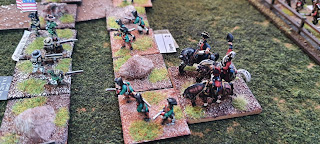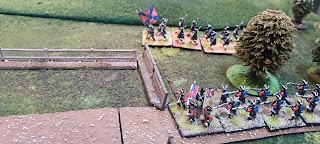Your roving reporter attended a game between the two Stephens, using Live Free or Die rules.
The battle was the ever popular Guilford CourtHouse: Cornwallis' Pyrrhic victory over the rebels in the south; the scenario again taken from the LFoD scenario book.
I still really like these rules. There are a few queries re. removal of DMZs (in rules as written - these are ALL removed once a base is removed - even the 'change'), and volley fire in woods etc, though I think some of the previous sensibilities with 'Loose File and American Scramble' clears up much of the concerns in that (1) the game is about morale, and managing it, rather than managing base losses and (2) the effectiveness of the units is also concerned with firing etc. such that close in work is both melee and firing, and longer range 'shooting' is thereby less effective, and hits morale rather than being immediately decisive - which reflects American and British tactics neatly,
I think. LFaAS handles this in theory, and LFoD has not captured all of it perhaps, but that's an improved playability issue for LFoD I feel, and the game does play beautifully.
(Also see Dale's blog post, a great review, where a brief examination vs Slack Chowder is outlined.)
There are a lot of pics here...the minis and terrain are 15mm from the collection of the two Steves - which all looks superb. As our friendly
neighbourhood google blogger control function is relentlessly mucking me about this evening, the
pics are in reverse order duhhh. I left early, but understand that the Americans lost their commander, which affected what they were able to do later in the game, and that 10 turns wouldn't be enough to capture the objective, though victory is based on stand losses, so a British win.







































The battle looks good, Darren. Now, you can probably anticipate my question...
ReplyDeleteHow do our games with FoH compare with these rules?
Very different Jon. I do not think LFoD would work in the same manner as FoH does for multiplayer games. I know the Little Wars guys did a large battle with the system, but they had multiple referees.
DeleteFoH delineates movement and attacks more neatly (via hexes) and is faster, yet looks at the bigger picture , and yet on a smaller battlefield.
I can do more with my forces in FoH, yet they can be more fragile. I need to manage my strengths, as I know I can't get it back - hence, FoH forces you to think one or two moves ahead - most certainly - I think that's the main difference.
It's relatively difficult to think ahead in LFoD - you're mainly reacting to the opponent. Both are strengths, yet FoH does make you feel more like you are co-coordinating a larger action.
That all looks nice. I can see why you like LFoD. These posts led me to take another look at Andy S's LFaAS. Good stuff all round.
ReplyDeleteThe more I look at it, the more I think how perfect the system is for 1680-1710 period.
DeleteThere are advantages to having good command, units are fairly fragile, and key to the period in my view - combat is very inefficient. I think the rules, with a modicum of amendment to suit period, would be absolutely superb for Aughrim et al.
shoot me an email at ducdegobin at gmail dot com - and i can send some thoughts
Thanks, I'll do that. Give me a couple of weeks I'm currently pre occupied with rules for The Indian Mutiny.
DeleteThe game certainly looks impressive. Hard to capture the full essence of the period in such a brief set I guess.
ReplyDeleteI think they capture it well, for the most part. By playing to the rules, there is plenty of AWI flavour, I think.
DeleteA great looking game and I would have been able to guess the battle from the lines of Americans in the first (last, thanks Blogger!) image. Sounds like the end result was a rough approximation of the real thing, which is what ahs happened the couple of time I have played this scenario - low American morale for the militia and extra high for the British ensures the units can get through the three lines of American troops, but by the end of it all, the British are badly mauled
ReplyDeleteThat does about sum it up, yes. It's a tough ask to trawl along the length of the board for the British, and the American's defence in depth works, but at a cost. But a great game. I guess the scenario outcome hangs by a thread in most cases, with only a tactical victory to be won in the end for any side.
DeleteAre the pictures in reverse or are both sides being gradually reinforced?.
ReplyDelete...and withdrawing in good order?
DeleteGood point that man!
DeleteNah, they're in reverse as I took them - which is why there is manic battle at the start, and subtle maneuvering at the end ;)
Great looking game and lovely photos, whatever the order!*
ReplyDeleteI am always interested in thoughts and musings about rules. I really enjoyed Little Wars' wonderful Brandywine video. Great stuff as always. Greg and Tom's play-through/review of their rules suggested that they were not for me (can't recall why), but then I am not in the market anyway (ha, ha). What I do appreciate is their continued efforts to produce systems that can make it easy for newbies to begin. They are doing all they can to ensure that they are not the 'last men standing' as far as miniature wargames as a hobby goes.
Regards, James
(*For what it is worth; I have not had a problem with re-ordering of photos for a while. I had taken to de-selecting all of the photos after I had uploaded them and then re-selecting them in order. I still load them a few at a time and insert the relevant ones between bits of text, which I have generally written first.)
Thanks James. Yes, I know what you mean. Some rules work, and with others we can see why choices were made for simplicity. That works for me in this case. Also very impressed with the scenario pack - with formats and leaders etc. all in one place. A nice AWI package, be it intro or otherwise.
Delete